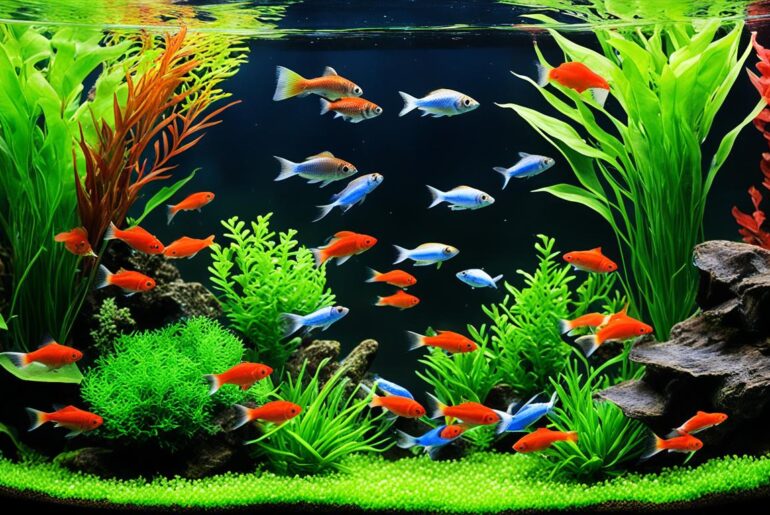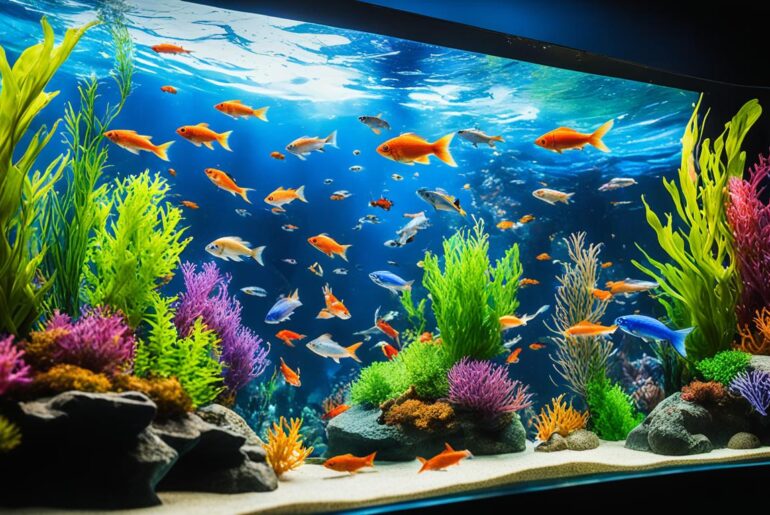As an avid aquarium enthusiast, I’ve always found solace in the vibrant and serene world of underwater landscapes. There’s something truly captivating about watching colorful fish gracefully glide amidst lush aquatic plants. It’s a sight that brings tranquility and beauty into my home.
But I’ll be honest – my busy schedule doesn’t always leave me with enough time to tend to high-maintenance plants or deal with the complexities of advanced aquarium care. That’s why I’ve searched far and wide for the perfect low-maintenance freshwater aquarium plants that require minimal effort to thrive.
These plants have not only added a touch of natural elegance to my aquarium, but they’ve also made it easier for me to maintain a healthy and balanced ecosystem for my fish. Whether you’re a beginner or simply looking for hassle-free plants, these low-maintenance options are sure to bring joy and serenity to your underwater oasis.
Key Takeaways:
- Discover 10 low-maintenance freshwater aquarium plants that are perfect for beginners.
- Add natural beauty to your aquarium while minimizing the effort required for care.
- Create a balanced ecosystem for your fish with easy-to-care-for aquatic plants.
- Enjoy the tranquility and serenity of underwater landscapes in the comfort of your home.
- Find the perfect low-maintenance plants that fit your personal style and preferences.
Marimo Moss Ball
When it comes to low-maintenance aquarium plants, the Marimo Moss Ball is a standout choice. This unique plant is actually a ball of cladophora algae, which gives it a distinctive appearance. Its spherical shape and vibrant green color make it an eye-catching addition to any aquarium.
The Marimo Moss Ball requires minimal care, making it ideal for beginners or busy aquarists. It thrives in a wide range of water conditions, including both freshwater and brackish water tanks. Unlike other plants that need to be anchored or planted, the Marimo Moss Ball simply floats or rolls along the tank’s surface.
To maintain its shape and promote healthy growth, gently roll the Marimo Moss Ball in your hands during water changes. This action prevents the algae from becoming compacted or developing flat spots. It’s like giving it a spa treatment to keep it looking its best!
“The Marimo Moss Ball is not only aesthetically pleasing but also serves a practical purpose in the aquarium. It helps to absorb nitrates and other organic waste, helping to keep the water clean and reduce the growth of algae.”
Having a Marimo Moss Ball in your aquarium provides numerous benefits beyond its visual appeal. Its presence helps to promote a healthy and balanced ecosystem for your aquatic inhabitants. The Marimo Moss Ball acts as a natural filter, removing toxins and pollutants from the water while also providing shelter and a food source for small aquatic creatures.
Overall, the Marimo Moss Ball is an excellent choice for aquarists looking to add a low-maintenance plant that offers both beauty and functionality to their aquarium. Its easy-care nature and unique appearance make it a favorite among hobbyists of all skill levels. So why not bring some green magic into your underwater world with the Marimo Moss Ball?
Amazon Sword
When it comes to classic aquarium plants that can grow large and add a striking focal point to your underwater landscape, the Amazon Sword is a top contender. With its tall, broad leaves and vibrant green color, this plant creates a beautiful and natural ambiance in any aquarium.
One of the reasons why the Amazon Sword is a favorite among aquarists is its low-maintenance nature. It’s well-suited for beginners or those who don’t have much time to devote to plant care. However, like any living organism, it still requires some attention to thrive.
To ensure the healthy growth of your Amazon Sword, you’ll need to provide it with the necessary nutrients. While some aquarium plants may rely solely on the nutrients in the water column, the Amazon Sword benefits from root tabs. These small, fertilizer-filled capsules are inserted into the substrate near the plant’s roots, providing it with essential nutrients it needs to thrive.
It’s important to note that Amazon Sword plants may have been grown emersed before they are sold. When transitioning to a submerged environment, the emersed leaves might melt back. Although this can initially be concerning for aquarists, it is a natural process as the plant acclimates to its new underwater habitat.
One of the unique features of the Amazon Sword is its ability to produce baby plants, also known as plantlets or runners. These offshoots can be removed from the parent plant and planted in other areas of your aquarium, allowing you to propagate and expand your Amazon Sword population.

| Pros | Cons |
|---|---|
|
|
Cryptocoryne wendtii
I’m excited to introduce you to Cryptocoryne wendtii, a low-maintenance crypt that will thrive in a variety of lighting and substrate conditions. Whether you’re a beginner or an experienced aquarist, this versatile plant is a fantastic addition to any aquarium.
Cryptocoryne wendtii is a hardy and resilient plant that doesn’t require the use of liquid fertilizers or CO2 injection. Instead, it draws nutrients from its roots, making it an excellent choice for low-maintenance setups. With its ability to tolerate different light levels, you can easily incorporate it into your existing tank without worrying about upgrading your lighting system.
During the initial stages, you may notice some melting of the leaves. Don’t panic! This is a normal part of the acclimation process, and the plant will bounce back and produce new growth. Give it some time, and soon you’ll see beautiful, healthy leaves emerging.
To provide optimal nutrition for Cryptocoryne wendtii, consider using aquarium root tabs. These convenient tablets can be placed in the substrate near the plant’s roots, providing essential nutrients for healthy growth. With the right care and feeding, this low-maintenance crypt can thrive and become a stunning focal point in your aquarium.
“Cryptocoryne wendtii is a versatile and easy-to-care-for plant that adds beauty and color to any aquarium. Its adaptability to different lighting and substrate conditions makes it a popular choice among aquarists of all skill levels.”
Experience the beauty of Cryptocoryne wendtii and enhance your aquarium with its vibrant foliage. Check out the image below to get a closer look at this stunning plant:
Aponogeton crispus
Aponogeton crispus is a beautiful and easy-to-care-for low-light aquarium plant that grows from a bulb. Its unique wavy-edged leaves add a touch of elegance to any aquatic setting. This bulb plant can go through a dormant period before producing new growth, making it a fascinating addition to your tank.
Unlike many other aquarium plants, Aponogeton crispus thrives in low-light conditions, making it an ideal choice for aquariums with minimal or indirect lighting. This plant doesn’t require intense lighting or CO2 injection, making it beginner-friendly and perfect for those looking for low-maintenance options.
One of the standout features of Aponogeton crispus is its ability to produce flowers. Under the right conditions, this bulb plant can grace your aquarium with delicate and fragrant blooms, adding a splash of color and interest to your aquatic oasis.
Now, let’s take a closer look at the key features and care requirements of Aponogeton crispus.
Key Features of Aponogeton crispus
| Plant Name | Aponogeton crispus |
|---|---|
| Plant Type | Bulb Plant |
| Difficulty Level | Easy |
| Lighting Level | Low |
| CO2 Requirement | Not required |
| Preferred Water Parameters | Temperature: 72-82°F; pH: 6.0-7.5 |
| Growth Rate | Slow to Moderate |
| Propagation Method | Bulb Division |
Aponogeton crispus Care Guide
Caring for Aponogeton crispus is relatively straightforward, making it an excellent choice for beginners. Here are some essential care tips to keep your Aponogeton crispus thriving:
- Lighting: Place your Aponogeton crispus in an area of your aquarium with low to moderate lighting. Avoid extremely bright lights, as they may cause algae growth or damage the plant.
- Substrate: Provide a substrate that is rich in nutrients to support the growth of your Aponogeton crispus bulb. You can use specialized aquatic plant substrates or add root tabs to ensure the plant receives essential nutrients.
- Water Parameters: Aponogeton crispus prefers water temperatures between 72-82°F and a slightly acidic to neutral pH level (6.0-7.5).
- Propagation: To propagate Aponogeton crispus, carefully divide the bulb into smaller sections and replant them in the substrate. Each new section should have several healthy leaves and an intact root system.
With proper care and maintenance, your Aponogeton crispus will reward you with its stunning foliage and the occasional beautiful bloom. Sit back, relax, and enjoy the natural beauty this low-light aquarium plant brings to your aquatic paradise.
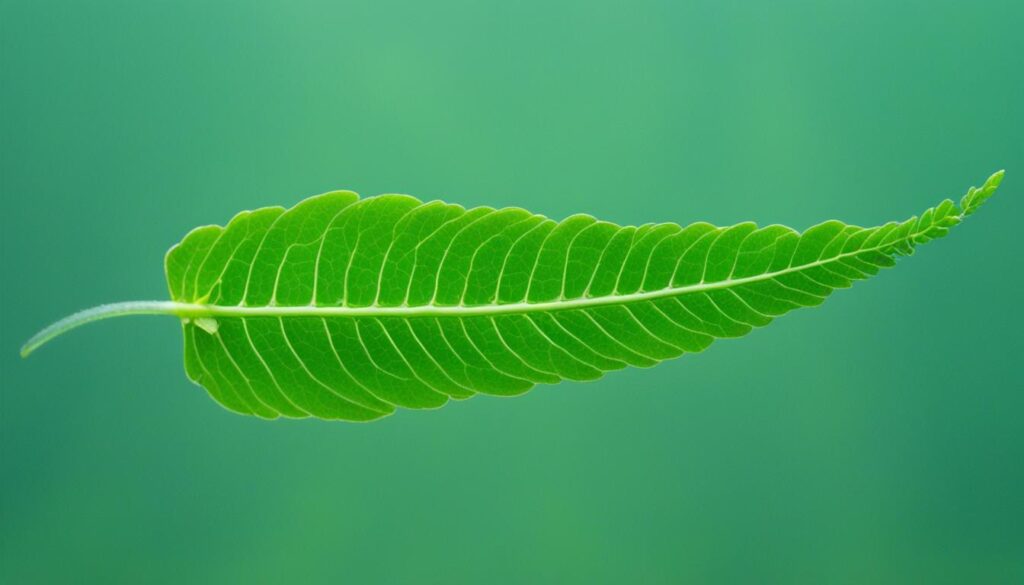
Bacopa caroliniana
Bacopa caroliniana is an excellent choice for beginners looking to add some greenery to their aquarium. This stem plant, also known as Moneywort, is known for its ease of care and adaptability to various light conditions. Whether you have low or medium light, Bacopa caroliniana will thrive and add a vibrant touch to your aquatic landscape.
One of the great things about Bacopa caroliniana is that it doesn’t require CO2 injection to thrive. This makes it an ideal choice for those who prefer a low-tech setup. However, to promote healthy growth and vibrant colors, it is recommended to provide liquid fertilizers to ensure that the plant gets the necessary nutrients.
Bacopa caroliniana can be propagated easily by cutting the tops of the stems and replanting them. This allows you to create new plants without having to purchase more. It’s a cost-effective way to expand your aquarium’s greenery and create an appealing visual effect.
To give you a better understanding of the key characteristics of Bacopa caroliniana, here’s a brief summary:
- Plant type: Stem plant
- Difficulty level: Easy
- Lighting requirements: Low to medium
- CO2 requirement: Not necessary
- Preferred growth substrate: Not specific
- Propagation method: Cuttings
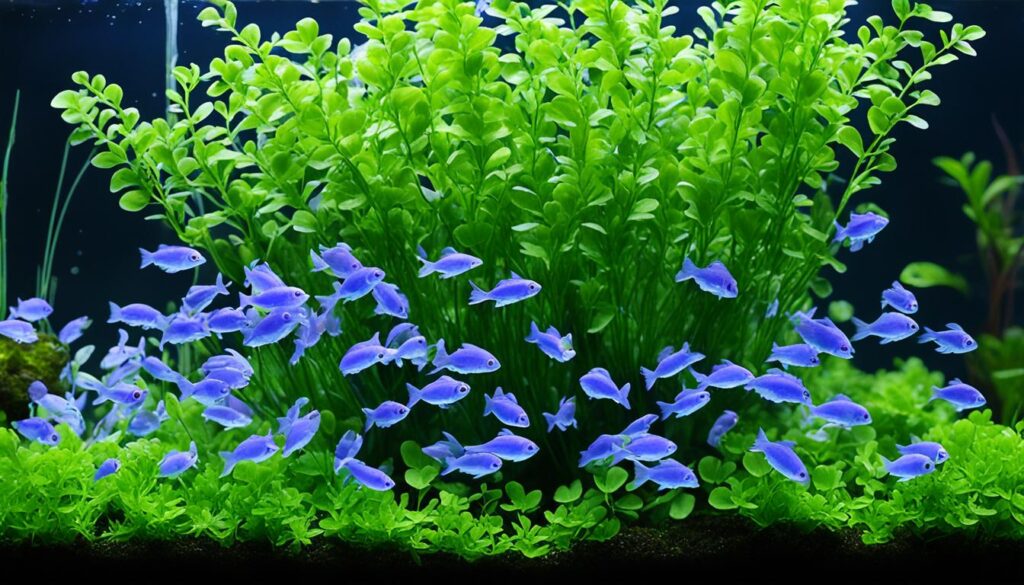
Adding Bacopa caroliniana to your aquarium will not only enhance its visual appeal but also contribute to the overall health of your aquatic ecosystem. Give this easy aquarium plant a try and enjoy the benefits it brings to your underwater world.
Christmas Moss
Christmas Moss is a slow-growing moss that adds a touch of elegance to any aquarium. It is a popular choice for breeding tanks and creating a mesmerizing moss-covered forest. This low-maintenance moss brings a natural look to your aquatic landscape.
Christmas Moss benefits from the company of small algae eaters as they help control algae growth, keeping your tank clean and healthy. Additionally, providing liquid fertilizer will ensure that the moss receives essential nutrients for optimal growth.
If you’re looking to create a lush, green underwater environment with a hint of enchantment, Christmas Moss is the perfect choice for you.
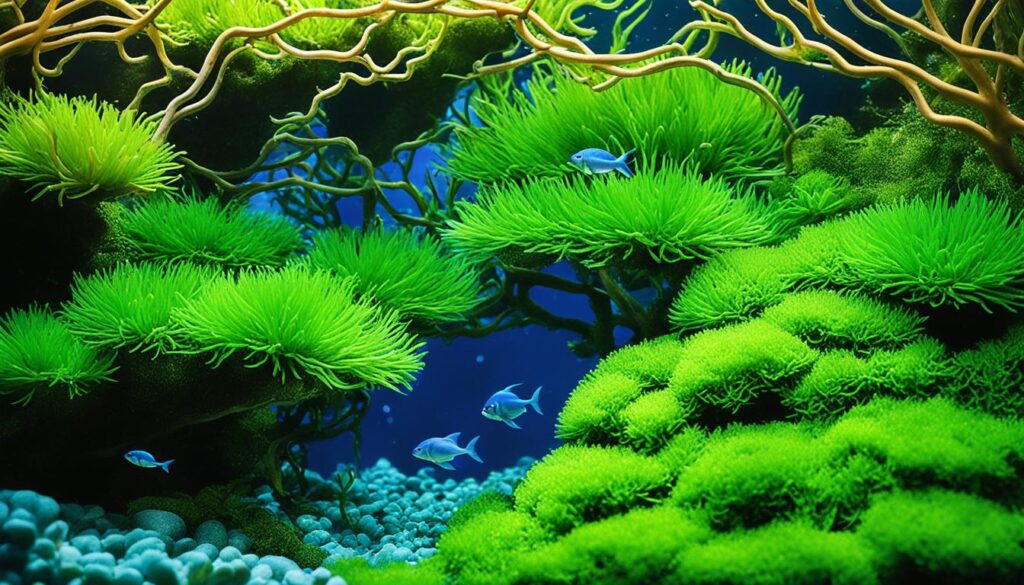
| Benefits of Christmas Moss | Requirements |
|---|---|
| Enhances the visual appeal of aquariums | Medium to bright lighting |
| Provides hiding places for small fish and shrimp | Temperature: 68-82°F (20-28°C) |
| Helps maintain water quality by absorbing nitrates | pH: 6.0-8.0 |
| Creates a natural habitat for aquatic life | Soft to moderately hard water |
Note: It is important to anchor Christmas Moss to rocks, driftwood, or other aquarium decorations to prevent it from floating freely in the tank.
Vallisneria
When it comes to creating a lush and vibrant underwater jungle in your aquarium, look no further than Vallisneria. This low-maintenance aquarium plant is perfect for beginners and aquarists who want to add a touch of nature to their tanks without the hassle of constant maintenance.
Vallisneria is known for its long, ribbon-like leaves that resemble grass. It spreads by making side shoots, forming dense clusters that provide shelter and hiding places for fish and other aquatic creatures. With its quick growth rate, it won’t take long for your tank to transform into a stunning underwater paradise.

One of the advantages of Vallisneria is its ability to withstand fish that may dig or eat plants. This makes it an excellent choice for aquariums with active or herbivorous fish species. You can rest assured knowing that your Vallisneria will thrive and maintain its beauty even in the presence of mischievous tank inhabitants.
Not only does Vallisneria enhance the aesthetic appeal of your aquarium, but it also serves a practical purpose. As a natural oxygenator, it helps improve water quality by absorbing excess nitrates and promoting a healthy environment for your aquatic pets.
Growing Vallisneria: Easy Care Tips
Growing and maintaining Vallisneria is a breeze. Here are some essential care tips:
- Lighting: Vallisneria thrives in moderate to high lighting conditions. Ensure that your aquarium receives sufficient light to support its growth.
- Substrate: Although Vallisneria can tolerate various types of substrates, it prefers nutrient-rich substrates that provide essential minerals and anchorage. Consider using a substrate specifically formulated for aquatic plants.
- Water Conditions: Vallisneria can adapt to a wide range of water conditions, but it thrives in slightly alkaline to moderately acidic pH levels (6.5-7.5) and water temperatures between 72°F and 82°F.
- Propagation: Vallisneria reproduces through runners that develop into new plantlets. As the plant spreads, you can trim and replant the runners to control its growth and maintain the desired appearance in your aquarium.
With its stunning appearance and low-maintenance nature, Vallisneria is an excellent choice for any aquarist looking to create a captivating underwater jungle. Whether you’re a beginner or an experienced hobbyist, this aquatic plant will thrive in your tank, transforming it into a natural oasis.
So, why wait? Dive into the world of Vallisneria and watch your aquarium come to life with the beauty of lush greenery.
Java Fern
When it comes to low-maintenance aquarium plants, Java Fern is a top choice for many fishkeepers. This hardy plant is well-suited for beginners and adds a touch of greenery to any aquarium.
Java Fern, scientifically known as Microsorum pteropus, is a rhizome plant that naturally attaches itself to driftwood or rocks. Its unique appearance adds visual interest to your tank, creating a natural and tranquil underwater scene.
This low-maintenance aquarium plant thrives in moderate to low lighting conditions, making it suitable for a wide range of setups. It doesn’t require extensive care or specialized equipment, making it ideal for beginner aquarists or those with busy schedules.
Occasional pruning helps promote healthy growth and prevents overcrowding. Simply trim off any yellowing or damaged leaves using clean scissors.
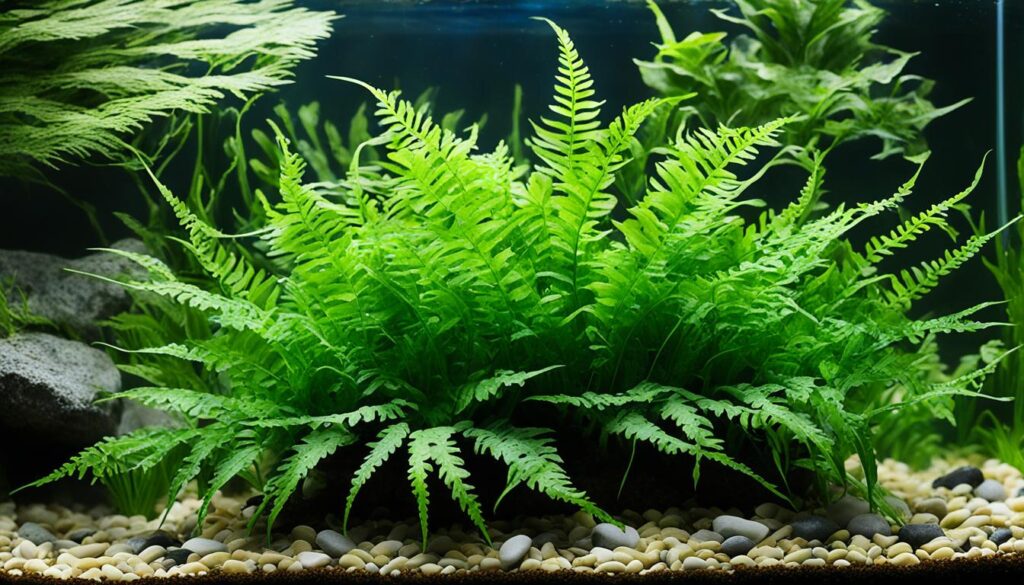
One noteworthy aspect of Java Fern is its ability to tolerate a variety of water parameters. It can thrive in both freshwater and slightly brackish water setups, allowing for more flexibility in your aquarium design.
Whether you have a community tank or a specialized biotope, Java Fern can be an excellent addition. It not only enhances the aesthetics of your aquarium but also provides shelter and hiding places for your aquatic inhabitants.
Here’s a quick overview of the key characteristics of Java Fern:
| Common Name | Java Fern |
|---|---|
| Scientific Name | Microsorum pteropus |
| Plant Type | Rhizome Plant |
| Growth Rate | Slow |
| Lighting Requirement | Moderate to Low |
| Difficulty Level | Easy |
| Placement in Tank | Foreground or Attached to Driftwood/Rocks |
Table: Characteristics of Java Fern.
Crypts (Cryptocoryne sp.)
Crypts, also known as Cryptocoryne, are highly sought-after freshwater aquarium plants due to their diverse range of coloration and leaf shapes. They are popular among aquarists for their low-maintenance nature, making them an excellent choice for beginners and busy aquarium enthusiasts.
These low-maintenance aquarium plants prefer low to moderate lighting conditions, making them suitable for a variety of setups. They can tolerate a wide range of water parameters and are generally hardy, making them a reliable choice for any freshwater aquarium.
One noteworthy characteristic of Crypts is their unique vascular system. They are rhizome plants, meaning they have a horizontal stem called a rhizome that produces roots and leaves. This rhizome allows the plant to easily adapt and recover from any damage or stress, making them resilient in various aquatic environments.
While Crypts are generally easy to maintain, they do require some nutrients from the substrate. Adding root tabs or nutrient-rich substrate can promote optimal growth and vibrant coloration. Additionally, providing CO2 injection can help stimulate faster growth and enhance overall plant health.
“Crypts are versatile and visually appealing plants that add an element of natural beauty to any aquarium. Their unique leaf shapes and colors create a captivating underwater landscape. Whether you’re a beginner or an experienced aquarist, adding Crypts to your tank will surely enhance its beauty and provide a low-maintenance aquatic experience.”
| Benefits of Crypts in the Aquarium |
|---|
| 1. Low-maintenance nature |
| 2. Diverse leaf shapes and colors |
| 3. Resilient and adaptable |
| 4. Suitable for various lighting conditions |
| 5. Enhances the natural beauty of the aquarium |
Adding Crypts to your aquarium will not only provide a beautiful visual backdrop but also contribute to the overall well-being of your aquatic ecosystem. These low-maintenance plants are a fantastic addition to any freshwater tank, offering a touch of nature with minimal effort.
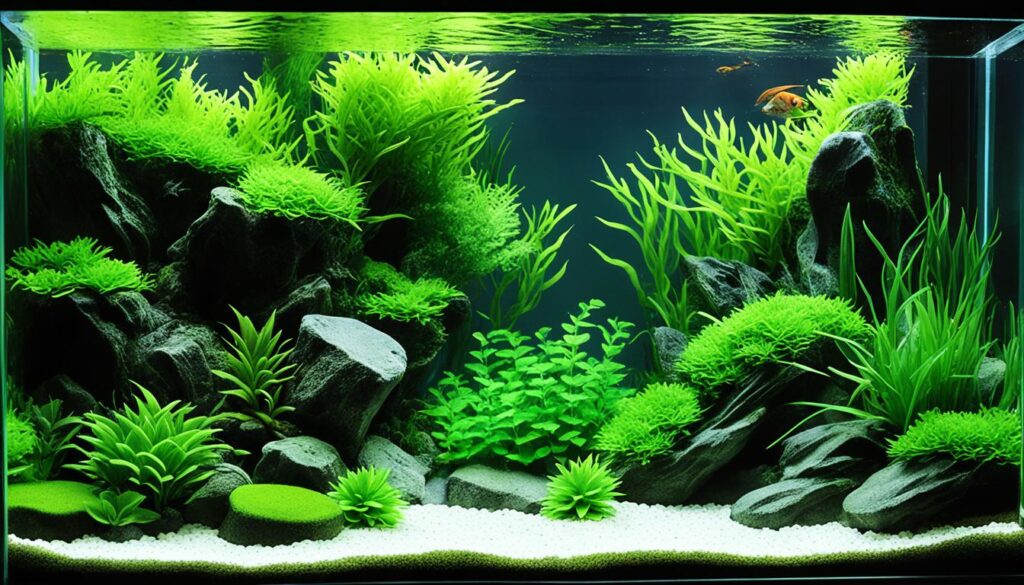
Conclusion
As I conclude this article on low-maintenance freshwater aquarium plants, it’s clear that these easy care aquatic plants are a perfect choice for both beginners and busy aquarists. With their vibrant colors, interesting textures, and diverse growth patterns, they add a touch of natural beauty to any aquarium. The best part? These hardy freshwater plants require minimal care, making them ideal for those who want a stunning planted tank without dedicating hours to maintenance.
Whether you opt for the Marimo Moss Ball, the Amazon Sword, or the Aponogeton crispus, you can rest assured knowing that these plants are beginner-friendly and don’t demand excessive attention. Their ability to consume fish waste and provide oxygen to the tank creates a harmonious environment for both your aquatic plants and fish. Plus, many of these low-maintenance plants can even propagate, allowing you to create beautiful displays in multiple aquariums or share them with fellow aquarists.
So, why wait? Take the plunge and transform your aquarium into an enchanting underwater paradise with these low-maintenance freshwater aquarium plants. From the easy care Bacopa caroliniana to the moss-covered wonder of Christmas Moss, there’s a plant to suit every aquarist’s taste and style. Embrace the beauty of nature with these hardy plants and enjoy the tranquility they bring to your aquatic world.
FAQ
What are some low-maintenance freshwater aquarium plants?
Here are 10 low-maintenance freshwater aquarium plants for easy care:
What is a Marimo Moss Ball?
The Marimo Moss Ball is a unique and easy aquarium plant. It is actually a ball of cladophora algae that requires minimal care. It should be rolled in your hands during water changes to maintain its shape.
What is an Amazon Sword?
The Amazon Sword is a classic aquarium plant known for its ability to grow large. It requires root tabs for nutrition and its emersed-grown leaves may melt back when submerged. It can produce baby plants that can be planted in other aquariums.
What is Cryptocoryne wendtii?
Cryptocoryne wendtii is a low-maintenance crypt that does well in various light and substrate conditions. It doesn’t require liquid fertilizers or CO2 injection but prefers feeding from its roots. It may melt back initially but will rebound and grow new leaves.
What is Aponogeton crispus?
Aponogeton crispus is a low light plant that grows from a bulb. It creates beautiful, wavy-edged leaves and can go through a dormant period before new growth. It is easy to care for and can even produce flowers.
What is Bacopa caroliniana?
Bacopa caroliniana is a beginner-friendly stem plant that can grow in low light conditions. It doesn’t require CO2 injection but benefits from liquid fertilizers. It can be propagated by cutting the tops and replanting them.
What is Christmas Moss?
Christmas Moss is a slow-growing moss that is popular for breeding tanks and creating a moss-covered forest. It benefits from small algae eaters and liquid fertilizer.
What is Vallisneria?
Vallisneria is an easy-to-care-for plant that can create an underwater jungle in your aquarium. It spreads by making side shoots and can withstand fish that may dig or eat plants.
What is Java Fern?
Java Fern is a popular and hardy aquarium plant that attaches to driftwood or rocks. It thrives in moderate to low lighting and benefits from occasional pruning.
What are Crypts?
Crypts are known for their range of coloration and leaf shapes. They are generally easy to maintain but prefer low to moderate lighting and some nutrients from the substrate. CO2 injection can promote faster growth.

